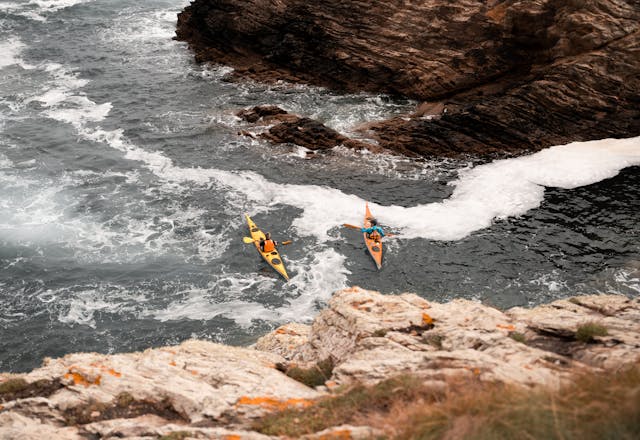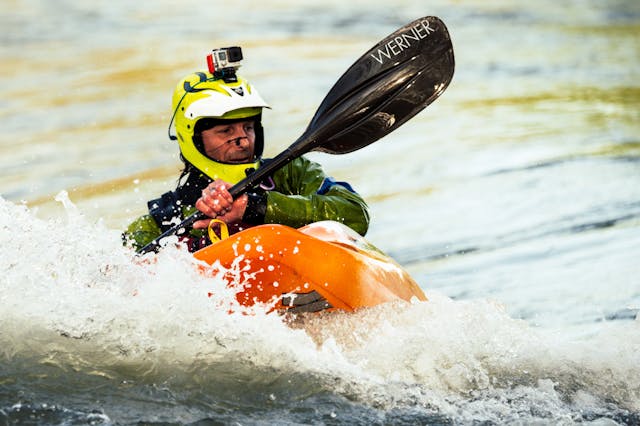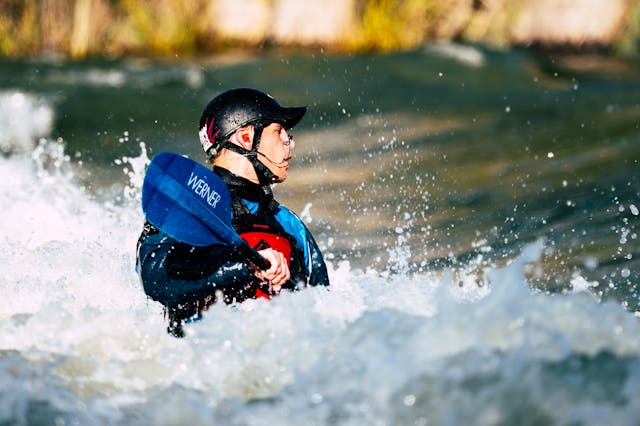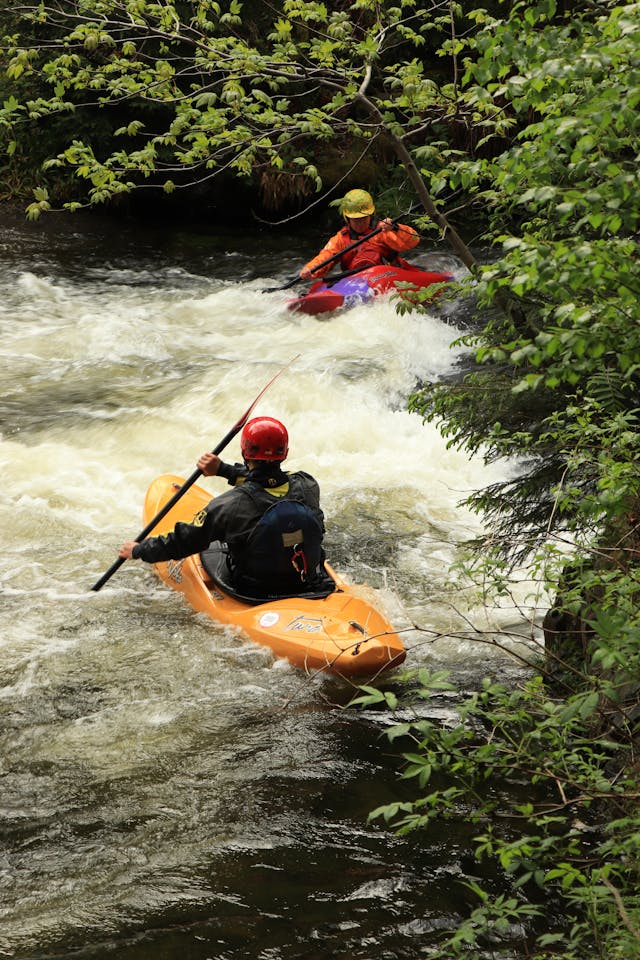Kayaking is a fun and exciting activity, but it’s easy to make mistakes, especially if you’re a beginner. One of the most important things to remember is always to wear a Personal Flotation Device (PFD), as it can be the difference between life and death in case of an accident. Overlooking such safety measures can turn a thrilling day into a dangerous adventure.

Another common mistake is to wear clothing suitable for the weather instead of the water. While it might be sunny and warm, the water can be cold and unpredictable, leading to an uncomfortable and risky situation. Choosing the right gear not only keeps you safe but also makes your kayaking experience more enjoyable.
Planning your trip is equally crucial. From selecting proper equipment to mapping out your route, preparation can prevent many issues during your kayaking trip. Knowing how to deal with potential hazards and how to handle a capsized kayak will also keep you safe and confident on the water.
Key Takeaways
- Always wear a PFD for safety.
- Dress appropriately for the water, not just the weather.
- Proper planning and preparation enhance your kayaking experience.
Understanding Kayaking Basics
Getting started with kayaking involves knowing the types of kayaks and mastering basic paddling techniques. This will help you navigate the waters more efficiently and safely.
Kayak Types and Purposes
The type of kayak you choose depends on the kind of water and activity. Recreational kayaks are designed for calm waters like lakes and gentle rivers. They’re wider for added stability, perfect for beginners who need a steady vessel.
Touring kayaks are longer and thinner, built for speed and long trips. They’re ideal for more experienced paddlers. Whitewater kayaks are short and have high maneuverability, suitable for swiftly moving and rough waters.
Sit-on-top kayaks are great for beginners due to their ease of use and getting back on if you fall off. Meanwhile, sit-inside kayaks offer better protection from the elements, which is helpful in cooler conditions.
Basic Paddling Techniques
Proper paddling techniques make your kayaking experience smoother and less tiring. Hold your kayak paddle with both hands, keeping a comfortable distance between them. Use your torso to power each stroke, not just your arms, to prevent fatigue.
Forward strokes are essential for moving ahead. Paddle on one side, then the other, maintaining an even rhythm. Sweep strokes help in turning the kayak. Extend your paddle to one side in a wide arc to turn.
For more precision, draw strokes pull the kayak sideways. Place the paddle in the water and pull towards you. Practicing these strokes ensures better control and stability, essential for all kayaking activities.
Essential Safety Guidelines

When kayaking, it’s crucial to follow some key safety guidelines to ensure a safe and enjoyable experience. Taking the proper precautions can help prevent accidents and injuries.
Wearing a Life Jacket
We always wear our PFD (Personal Flotation Device) when kayaking. A life jacket is essential because it can save your life if you fall into the water. Don’t think of it as optional gear; it’s a must-have.
A well-fitted life jacket keeps your head above water and helps you float. Ensure it’s snug but comfortable. It’s important for everyone, whether you’re a beginner or an expert.
Having a life jacket on is non-negotiable. Even strong swimmers can encounter problems, like unconsciousness from a collision. So always make it a habit to wear one.
Understanding Water Safety
Staying safe on the water involves knowing the basics of water safety. Always kayak with a buddy. It’s safer and more fun! Being in shallow water doesn’t guarantee safety. Many accidents happen in less than three feet of water.
Carry a whistle for emergencies. If you need help, three short blasts are a distress signal. Always stay visible to others, and avoid busy areas with lots of boats.
Check water temperature before heading out. Cold water can be dangerous. Wear a wetsuit or drysuit in temperatures below 60°F.
Weather and Environmental Awareness
Before we head out, we always check the weather forecast. Sudden storms or high winds can turn a relaxing trip into a dangerous situation. Using apps or checking online forecasts is a simple way to stay informed.
We avoid kayaking in bad weather. Strong winds can make paddling difficult, while storms can bring lightning and rough water. Always have sunscreen and stay hydrated to protect against sunburn and dehydration.
Be mindful of your surroundings. Stick close to shorelines, and avoid areas where speedboats and jet skis are frequent. This reduces the risk of accidents and helps you stay in calmer waters.
By following these essential safety guidelines, we can stay safe and enjoy our time on the water.
Planning Your Kayak Trip
Planning your kayak trip involves selecting an appropriate route and ensuring you have all necessary items. Proper preparation helps ensure a safe and enjoyable experience.
Route Selection and Weather Check
When choosing a route, research the waterways and check maps to avoid private property. It’s essential to know your paddling limits. Plan the distance according to how far you can kayak in a day, factoring in current and wind conditions.
Always check the weather forecast before leaving. Severe weather can make kayaking dangerous, so it’s best to avoid trips if storms are predicted. Use tools like weather apps to stay updated. Remember to inform someone about your route and expected return time.
What to Bring on Your Kayak
Packing the right items is vital for a successful trip. Start with safety gear like a Personal Flotation Device (PFD) and a first aid kit. Bring a navigation tool, such as a map or GPS, to stay on course.
Include clothing suited to weather conditions, like a fleece jacket for cold and rain gear. Food and water are necessary. Pack energy bars and ensure you have enough water to stay hydrated. Protect your valuables in waterproof bags. Lastly, carry a headlamp and fire starter for emergencies.
Proper planning and packing ensure a hassle-free kayaking adventure.
Common Kayaking Mistakes

There are several mistakes that kayakers make which can affect their paddling efficiency and safety. Two significant mistakes to watch out for are incorrect paddling form and ignoring the importance of balance.
Incorrect Paddling Form
Many beginners struggle with correct paddling form. One common problem is gripping the paddle too tightly. This can cause fatigue and reduce your control over the kayak.
Another issue is not rotating the torso. Efficient paddling requires your torso to rotate with each stroke. This spreads the effort across your upper body, not just your arms, making paddling easier and more effective.
Hand positioning is also crucial. Hands should be shoulder-width apart, and the paddle should be at a right angle to your body. This positioning maximizes the power of each stroke and maintains balance. If your strokes are uneven, you might end up zigzagging instead of moving in a straight line.
Make sure to use the full blade of the paddle and reach forward before dipping it into the water. This technique helps maintain a steady rhythm and propulsion.
Overlooking the Importance of Balance
Balance plays a key role in kayaking. Many people get into trouble by leaning too far back or forward, throwing off the kayak’s balance. The best posture is sitting upright with a straight back, which helps to evenly distribute your weight and maintain the kayak’s center of gravity.
Weight distribution in the kayak affects stability. Your hips should be aligned with the center of the boat. When turning or navigating rough waters, shift your weight subtly to maintain equilibrium. Minor adjustments can prevent capsizing and make your kayaking more enjoyable.
Remember, sudden and large movements can destabilize you. Practice smooth and controlled actions, especially when embarking or disembarking. This will help maintain overall balance and reduce the risk of tipping over.
Ignoring the weather can also disrupt balance. Always check weather conditions before heading out. Sudden changes can make water choppier and harder to navigate safely.
By focusing on proper technique and balance, we can enhance both our safety and enjoyment on the water.
Dealing with Kayak Capsizing

Capsizing is a common concern for kayakers, but with the right techniques, you can prevent it or safely recover if it happens. Here’s what you need to know.
Preventing Capsizing
Preventing a capsize starts with proper preparation and technique. Always use a personal flotation device (PFD). This is not just a recommendation; it’s essential for your safety.
Balance your load evenly between the front and back of your kayak. This keeps it stable and less likely to tip. Make sure your gear is tied down securely to avoid losing anything in the water. When encountering waves, tackle them head-on. Approaching waves at an angle can destabilize the kayak.
Proper paddling technique is crucial too. Keep your center of gravity low and make smooth, even strokes. Rapid or erratic movements can throw you off balance.
Safe Recovery from a Capsize
If you do capsize, stay calm and follow these steps to recover safely. First, try to hold on to your paddle and kayak. This will prevent them from drifting away.
Position yourself alongside the kayak, near the cockpit. Place your paddle across the kayak for stability. Slide your legs into the cockpit first, then carefully lift your body into the seat. This allows you to maintain balance and prevents the kayak from tipping again.
If you’re struggling to re-enter, you can use the Paddle Float technique. Secure a float to one end of your paddle, using it as an outrigger for support.
By practicing these techniques, you’ll be better equipped to handle capsizing scenarios. Remember, preparation and calm actions are key to a safe kayaking experience.
Avoiding and Navigating Hazards

When kayaking, it’s crucial to recognize and steer clear of obstacles, as well as manage currents and waves to stay safe on the water. Addressing these factors will help prevent accidents and make your experience more enjoyable.
Recognizing and Avoiding Obstacles
Recognizing obstacles like submerged rocks, fallen trees, or other debris is key. These objects can make your kayak unstable or cause you to capsize. It’s essential to keep a lookout ahead and react quickly.
To navigate these effectively, always scan the water for potential hazards. Busy waterways may have more obstacles due to high traffic, so being vigilant is necessary. In shallow water, submerged rocks and branches are more likely to be just below the surface, posing a risk you may not initially see.
Maneuvering around these hazards often requires quick paddling strokes or slight shifts in weight. Practicing these techniques beforehand can make a big difference in response time and effectiveness.
Dealing with Currents and Waves
Currents and waves can present significant challenges while kayaking. Knowing how to handle them will keep you safe and steady. When paddling in strong currents or against waves, it’s important to maintain a steady pace and keep your kayak’s nose pointed into the oncoming wave or current.
In what people typically ask us, “How do we avoid capsizing in strong waves?” The answer lies in adjusting your paddling technique and body posture. Lean slightly forward and use shorter, more controlled strokes. This helps maintain balance and reduces the chance of tipping over.
If you’re kayaking in a busy waterway, boat wakes can create unexpected waves. Always be prepared to adjust your positioning and paddle strokes. Paddling at an angle rather than directly into the wave can help stabilize your kayak.
Staying close to the shore whenever possible can provide more control and reduce the strength of waves and currents acting on your kayak.
Enhancing Paddling Efficiency and Endurance
We all want to have an enjoyable and efficient time on the water. To achieve that, focusing on the right paddling techniques and energy conservation methods is essential.
Developing a Proper Stroke
Achieving an efficient stroke is key to maintaining stamina and speed. First, engage your core rather than relying solely on your arms. This reduces fatigue and distributes the workload across more muscle groups. Ensure your paddle grip is relaxed but firm enough to control the paddle. Keeping a good posture will help you stay balanced and reduce strain.
Another tip is to use the whole length of your paddle. Start the stroke by submerging the blade completely and pulling it cleanly through the water. Avoid dragging the paddle too far behind you as it wastes energy and can cause you to veer off course. Aim for smooth and consistent strokes to maintain a steady rhythm.
Conserving Energy on the Water
Conserving energy is just as important as having a proper stroke. Plan your paddling sessions to include breaks and allow time for hydration and snacks. Paddling at a steady pace rather than sprinting helps in preserving your strength for long outings.
Another way to save energy is by taking advantage of the current and wind. Align your kayak’s direction with natural aids whenever possible. Using torso rotation instead of just your arms not only improves efficiency, it also helps reduce fatigue. Implementing efficient breathing techniques can further aid in maintaining energy levels.
Finally, consider incorporating exercises that build kayaker-specific strength, such as these circuit training routines. Activities like pull-ups, squats, and rows can enhance your paddling performance by targeting the muscles used in kayaking.
Staying Comfortable and Energized
When kayaking, staying comfortable and energized ensures a safe and enjoyable experience. Proper seating and fit, along with good food and hydration practices, are key.
Importance of Comfort and Fit
Having a comfortable seat is essential. If your seat is hard or doesn’t support your back, it can make your trip miserable. Foam or gel seat pads can help a lot. Adjust the seat and footpegs to fit your body size. This helps keep your posture right and avoid back pain.
Cold water can be dangerous. Proper gear helps avoid hypothermia. Neoprene wetsuits or dry suits provide insulation. Always check the water temperature and dress appropriately to keep warm and dry during immersion.
Food and Hydration Considerations
Staying hydrated is crucial. Bring enough water and drink regularly, especially in hot weather. Dehydration can cause fatigue and headaches, ruining your trip. Using a water bottle with a strap can make it easy to access while paddling.
Snacks help maintain energy. Pack high-energy foods like nuts, dried fruits, and energy bars. These snacks are easy to carry and eat. Avoid heavy meals which can make you feel sluggish. Small, frequent snacks keep energy levels steady throughout the day.
By focusing on comfort and proper hydration, you can enjoy kayaking more and stay safe out on the water. It’s not just about the paddle strokes, but also about taking care of your body while you’re having fun.
Respecting Nature and Regulations
Making sure we respect nature and follow the right regulations while kayaking helps us enjoy the activity safely. It also ensures we protect the environment for everyone to enjoy.
Familiarizing with Local Regulations
Every waterway has specific rules that we need to follow. These regulations can include wearing a Personal Flotation Device (PFD), specific zones where kayaking is allowed, and restrictions on the type of gear.
We always need to check if a permit is required for the waterway. Some areas have registration requirements, especially for larger kayaks or those with a trolling motor. Knowing these rules helps us avoid fines and ensures our safety.
Additionally, learning right-of-way rules prevents accidents. This means understanding when to yield to larger boats or other kayakers. By following local laws, we enjoy a safe and hassle-free experience.
Environmental Awareness and Conservation
When we kayak, it’s important to leave no trace. This means packing out all trash and avoiding disturbing wildlife. Environmental protection starts with simple habits like using biodegradable soap and keeping a safe distance from nesting areas.
Respecting nature also means using established launch sites and marked trails. This reduces the impact on fragile ecosystems. Erosion and water pollution can harm local wildlife, so staying on designated paths helps maintain the natural beauty.
We also ensure our kayaks are clean to prevent spreading invasive species. Rinsing our gear before moving to a new waterway helps protect the environment. By being mindful of these practices, we help preserve the natural world for future generations.
Frequently Asked Questions
In this section, we’ll cover safety techniques, injury prevention, essential skills, and important tips for first-time kayakers. These answers will help you get started and stay safe on the water.
Q: What safety techniques should beginners know before kayaking?
A: Beginners must always wear a Personal Flotation Device (PFD). It’s crucial to check weather conditions before heading out. Learning basic rescue techniques, like a self-rescue or how to assist others, is also important. Carrying a whistle for emergencies and paddling with a buddy can further ensure safety.
Q: How can a kayaker avoid common injuries associated with the sport?
A: Warming up before paddling can prevent muscle strains. Proper posture is key; sitting up straight and engaging your core helps avoid back pain. Using correct paddling techniques reduces the chance of repetitive strain injuries. Taking breaks and staying hydrated also help avoid fatigue-related injuries.
Q: What are the essential skills first-time kayakers must learn?
A: First-timers should learn how to paddle correctly, including forward stroke, reverse stroke, and turning. Steering and bracing skills help in maneuvering and stabilizing the kayak. Learning how to read water conditions also aids in navigating safely. Lastly, practicing wet exits and re-entries is essential for safety.
Q: Can you outline proper kayak entry and exit techniques for new paddlers?
A: To enter a kayak, place it parallel to the shore or dock. Sit on the edge and swing your legs in, keeping your balance. For exits, paddle close to the shore, swing your legs out, and stand up slowly. Practicing these moves in calm waters helps build confidence for more challenging environments.
Q: What should not be done while paddling to ensure a safe kayaking experience?
A: Avoid locking your arms while paddling. This can lead to fatigue and potential injury. Don’t lean back in the kayak seat; maintain an upright posture. Paddling too far from shore without the skill or endurance can be dangerous. Finally, never skip wearing your PFD.
How does the 120 rule apply to kayaking and why is it important?
A: The 120-degree rule states that the combined air and water temperature should not be below 120 degrees Fahrenheit to ensure safety from hypothermia. For example, if the air temperature is 70°F and the water is 50°F, you’re within the safe range. Dressing appropriately for cold water is crucial, even on warm days.
These tips and techniques will help you enjoy kayaking safely and effectively. For more detailed information and tips, you can visit guides like Common Kayaking Mistakes and Mistakes to Avoid.


1 thought on “Kayaking Mistakes: Common Errors and How to Avoid Them”